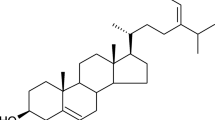Abstract
In this study, we showed that feeding rats the organic extract of scallop shells (scallop shell extract) caused a decrease in the weights of white adipose tissues in rats fed a high-fat diet. In addition, the cholesterol concentration in the serum of rats that received a diet containing scallop shell extract was significantly lower than that in the serum of rats on the control diet. Feeding this scallop shell extract to rats increased the fecal weight as well as the fecal excretion of bile acids. The amino acid composition of the feces from rats fed the scallop shell extract was different from that of feces from rats fed the control diet, and treatment of the extract with pepsin and pancreatin identified a protein with a molecular weight of 90 kDa (90-kDa protein) as one of the indigestible proteins. Interestingly the 90-kDa protein was found to be identical to a free radical-scavenging protein we previously identified and showed the ability to bind bile acids. These results suggest that indigestible proteins (resistant proteins) in the scallop shell extract, including the 90-kDa protein, inhibit the absorption of bile acid by binding to it and cause increased excretion of fecal bile acid, which subsequently may decrease the serum cholesterol level.







Similar content being viewed by others
References
Liu YC, Hasegawa Y (2006) Reducing effect of feeding powdered scallop shell on the body fat mass of rats. Biosci Biotechnol Biochem 70:86–92
Liu YC, Satoh K, Hasegawa Y (2006) Feeding scallop shell powder induces the expression of uncoupling protein 1 (UCP1) in white adipose tissue of rats. Biosci Biotechnol Biochem 70:2733–2738
Takahashi K, Satoh K, Katagawa M, Torita A, Hasegawa Y (2012) Scallop shell extract inhibits 3T3-L1 preadipocyte differentiation. Fish Sci 78:897–903
Tungland BC, Meyer D (2006) Nondigestible oligo- and polysaccharides (dietaryfiber): their physiology and role in human health and food. Compr Rev Food Sci Food Saf 1:73–77
Annison G, Topping DL (1994) Nutritional role of resistant starch: chemical structure vs physiological function. Annu Rev Nutr 14:297–320
Kato N, Iwami KJ (2002) Resistant protein; its existence and function beneficial to health. Nutr Sci Vitaminol 48:1–5
Higaki N, Sato K, Suda H, Suzuka T, Komori T, Saeki T, Nakamura Y, Ohtsuki K, Iwami K, Kanamoto R (2006) Resistant protein; its existence and function beneficial to health. Biosci Biotechnol Biochem 70:2844–2852
Kayashita J, Shimaoka I, Nakajoh M, Yamazaki M, Kato N (1997) Consumption of buckwheat protein lowers plasma cholesterol and raises fecal neutral sterols in cholesterol-fed rats because of its low digestibility. J Nutr 127:1395–1400
Sasaki M, Yamada H, Kato N (2000) A resistant protein, sericin improves atropine-induced constipation in rats. Food Sci Technol Res 6:280–283
Sugano M, Yamada Y, Yoshida K, Hashimoto Y, Matsuo T, Kimoto M (1998) The hypocholesterolemic action of the undigested fraction of soybean protein in rats. Atherosclerosis 72:115–122
Zhaorigetu S, Sasaki M, Watanabe H, Kato N (2001) Supplemental silk protein, sericin, suppresses colon tumorigenesis in 1,2-dimethylhydrazine-treated mice by reducing oxidative stress and cell proliferation. Biosci Biotechnol Biochem 65:2181–2186
Liu YC, Uchiyama K, Natsui N, Hasegawa Y (2002) In vitro activities of the components from scallop shells. Fish Sci 68:1330–1336
Mitsuhashi T, Ono K, Fukuda M, Hasegawa Y (2013) Free radical scavenging ability and structure of a 90-kDa protein from the scallop shell. Fish Sci 79:495–502
Smith PK, Krohn RI, Hermanson GT, Mallia AK, Gartner FH, Provenzano MD, Fujimoto EK, Goeke NM, Olson BJ, Klenk DC (1985) Measurement of protein using bicinchoninic acid. Anal Biochem 150:76–85
Bligh EG, Dyer WJ (1959) A rapid method of total lipid extraction and purification. Can J Biochem Physiol 37:911–917
Saura-Calixto F, Garcia-Alonso A, Goi I, Bravo L (2000) In vitro determination of the indigestible fraction in foods: an alternative to dietary fiber analysis. J Agric Food Chem 48:3342–3347
LaemmLi UK (1970) Cleavage of structural proteins during the assembly of the head of bacteriophage T4. Nature 227:680–685
Papakonstantinou E, Flatt WP, Huth PJ, Harris RBS (2003) High dietary calcium reduces body fat content, digestibility of fat, and serum vitamin D in rats. Obes Res 11:387–394
Shi H, Dirienzo D, Zemel MB (2001) Effects of dietary calcium on adipocyte lipid metabolism and body weight regulation in energy-restricted aP2-agouti transgenic mice. FASEB J 15:291–293
Sugano M, Goto S (1990) Steroid-binding peptides from dietary proteins. J Nutr Sci Vitaminol 36:S147–S150
Sugano M, Goto S, Yamada Y, Yoshida K, Hashimoto Y, Matsuo T, Kimoto M (1990) Cholesterol-lowering activity of various undigested fractions of soybean protein in rats. J Nutr 120:977–985
Iwami K, Sakakibara K, Ibuki F (1986) Involvement of post-digestion ‘hydrophobia’ peptides in plasma cholesterol-lowering effect of dietary plant proteins (food and nutrition). Agric Biol Chem 50:1217–1222
Iwami K, Kitagawa M, Ibuki F (1990) Effect of dietary proteins and/or their digestive products on intestinal taurocholate absorption. J Nutr Sci Vitaminol 36(Suppl. 2):S141–S146
Choi SK, Adachi M, Utsumi S (2002) Identification of the bile acid-binding region in the soy glycinin A1aB1b subunit. Biosci Biotechnol Biochem 66:2395–2401
Acknowledgments
The work was supported in part by a grant from Suhara Foundation.
Author information
Authors and Affiliations
Corresponding author
Rights and permissions
About this article
Cite this article
Fukuda, M., Takahashi, K., Ohkawa, C. et al. Identification of a resistant protein from scallop shell extract and its bile acid-binding activity. Fish Sci 79, 1017–1025 (2013). https://doi.org/10.1007/s12562-013-0676-8
Received:
Accepted:
Published:
Issue Date:
DOI: https://doi.org/10.1007/s12562-013-0676-8




